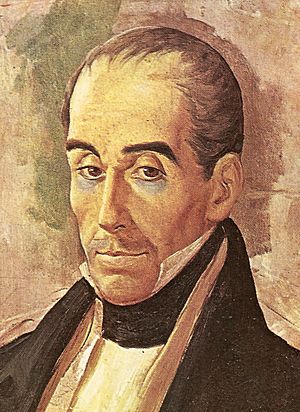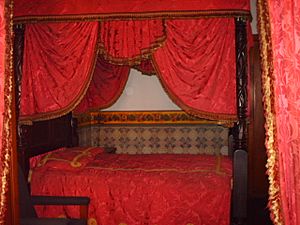Birthplace of Simón Bolívar facts for kids
Quick facts for kids Birthplace of Simón Bolívar |
|
|---|---|
|
Casa Natal del Libertador Simón Bolívar
|
|

Simón Bolívar's birthplace, Caracas
|
|
| General information | |
| Architectural style | Spanish Colonial |
| Location | Caracas, Venezuela |
| Country | Venezuela |
| Completed | 1643 |
| Inaugurated | 5 January 1921 |
| Renovated | 1920 |
| Client | Venezuelan government |
The Birthplace of Simón Bolívar (known as Casa Natal del Libertador Simón Bolívar in Spanish) is a historic house in Caracas, the capital city of Venezuela. This special house is where Simón Bolívar, a famous hero who helped many South American countries become independent, was born. He was born here on July 24, 1783.
Today, the house is a popular place for visitors. It stands on a small street near Plaza San Jacinto, just a short walk from the main Plaza Bolívar. It is one of the few old houses from the colonial times that are still standing in central Caracas. Next to it, there is a museum that shows items related to Bolívar and Venezuela's fight for freedom.
Contents
Simón Bolívar's Childhood Home
A Look at History
The house on San Jacinto Street was finished in the 1640s. Simón Bolívar was born in a bedroom here on July 24, 1783. His parents were Doña María de la Concepción Palacios y Blanco and Coronel Don Juan Vicente Bolívar y Ponte. They were an important family who had moved from Spain about 200 years earlier. Simón was their fourth child.
In 1806, the house was sold to a relative of Bolívar named Madriz. His family owned the house until 1876. Then, President Antonio Guzmán Blanco bought it. Guzmán Blanco admired Bolívar greatly. He even put up a statue of Bolívar on horseback in Plaza Bolívar.
On October 28, 1916, people decided to rebuild the house. This was to protect Venezuela's history and honor its national hero. The actual rebuilding started in 1920, and some new features were added. The house officially opened on January 5, 1921. This date was chosen because it was the anniversary of the Battle of Carabobo, an important battle for independence. The building became a protected National Monument on July 25, 2002.
The House's Design
The house has only one floor. It is quite long and narrow, about 23 meters wide and 60 meters deep. Inside, you will find wide hallways and open courtyards. The house was rebuilt to look like Spanish Colonial homes. However, the goal was to make the house even better, not just exactly like it was before.
New materials were used during the rebuilding. For example, the front of the house, which faces the street, is now made of stone. This was not typical for old colonial houses in Venezuela. Other walls are painted white. The structure underneath is now made of brick, but it was probably made of mud bricks (adobe) originally.
When Bolívar was born, his home was very fancy. It had mahogany chests and tables, soft chairs, and decorated mirrors. There were also silk curtains, gold decorations, and bright chandeliers. Today, you can see furniture and items from that time that belonged to Bolívar.
The house has several courtyards with hallways and rooms around them. In the main courtyard, you can see the baptismal font used for Bolívar's baptism. It was originally from Caracas Cathedral. The second courtyard helps keep the kitchen and other rooms cool. It also has a copy of a water fountain from Bolívar's time. At the very back of the house, there was a small laundry area and a stable for horses.
Some of the most important rooms are the main room, the bedroom where Simón Bolívar was born, and the study. These rooms are at the front of the house. They are decorated with large paintings by the artist Tito Salas. These paintings show Bolívar's brave battles and important moments from his life. One painting shows Bolívar on a white mountain with a white-bearded man who has angel wings. There are also paintings by Martín Tovar y Tovar and Arturo Michelena. These show scenes like his baptism, wedding, and death. In the backyard, there is a famous tree. It is said that Simón Bolívar was taught by Rodríguez under this tree.
You can also see items from Bolívar's childhood, like books from his library and his personal papers.
Other Homes of Bolívar
Homes in Venezuela
Some people believe Bolívar was born in the town of San Mateo, Aragua, not Caracas. They say his mother lived on a ranch in San Mateo shortly before he was born. Bolívar also spent a lot of time there as a child.
Another family home of Bolívar is also very important. It was where the movement for independence began on April 19, 1810. Freedom fighters had planned their actions during a meeting at this home in 1818. This movement eventually led to Venezuela gaining its independence from Spain on July 5, 1815.
Homes in Colombia
- Quinta de Bolívar
- Quinta de San Pedro Alejandrino
Gallery
See also
 In Spanish: Casa Natal del Libertador Simón Bolívar para niños
In Spanish: Casa Natal del Libertador Simón Bolívar para niños








